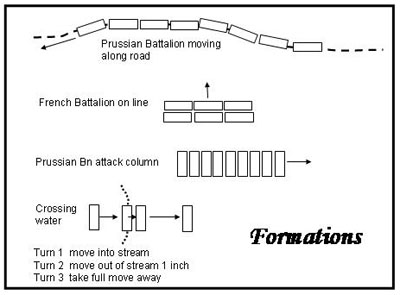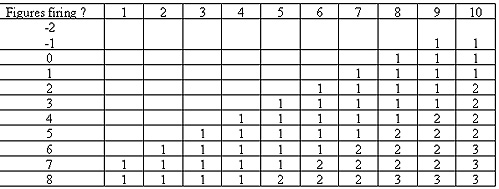 The object of the game is for the Prussians to attack Plancenoit. Therefore, when a Prussian battalion launches its assault, I consider that activity indicative of Prussian success.
The object of the game is for the Prussians to attack Plancenoit. Therefore, when a Prussian battalion launches its assault, I consider that activity indicative of Prussian success.
The general sequence of play is this. I formed up the Prussian march columns into two brigades. Each brigade had a single advance guard and one or two flank guards. Once I designated the order of march of infantry, artillery, and cavalry, I could not alter the sequence until after the forces had actually entered the battlefield. To help me plan, I photocopied maps of the battlefield and plotted out the routes of the various columns. I placed the two advance guards on the table up to ten inches on the board.
At the start of each turn, I roll to see if a French force shows up on the board that turn. A 1D6 roll of 1 or 2 means that a French force appears.
Then I roll a 1D20 to determine where this force appears.
If in the open, the French force starts in attack column facing in the most advantageous way. It can use subsequent turns to put itself in the best offensive or defensive posture. If the French force appears in a woods, then I posture it to best block the road. Often that means placing the stands along the front edge of the woods.
I wonít place a French force behind a Prussian force, that is to say, a location that the Prussians have already ďcleared.Ē For example, if a Prussian column has passed through checkpoint 6 enroute to checkpoint 9, then I wonít place a French force at 6. When this anomaly occurs, then I put the French at checkpoint 17.
Then I roll 1D6 for the composition of the French force. I treat French line and light identically because Iím persuaded that in 1815, qualitative differences had pretty much disappeared. You may want to treat these two infantry types differently.
I donít allow either cavalry or artillery to be placed in the woods because they canít fight there. If the location is in the woods and the roll indicates cavalry or artillery, then roll again until you get an all-infantry result.
Composition of French Forces
- 1: 3 companies infantry (2 line companies, 1 elite company)
2: 3 companies infantry (2 line companies, 1 elite company)
3: 3 companies infantry (2 line companies, 1 elite company)
4: Infantry battalion (4 line companies and both elite companies)
5: Battery plus 1 company infantry (1-4, 8# foot; 5-6, 6# horse)
6: Squadron dragoons (4-5 stands)
 Movement
Movement
Feel entirely free to use your own movement rules (you are a soloist, are you not?) Hereís what I used:
To get the on road rate, the infantry must be in march column. This means that a Prussian battalion of 8 stands is 1 inch wide and 24 inches long (8 three-inch stands).
My attack columns are one company (3 inches) wide. My line formation is half a battalion (3 or 4 stands) wide.
It takes half a move to change formation from attack column to line or reverse. It takes a full move to change from march column to line or attack column.
 Firing
Firing
I use home-grown firing rules. Simply stated, it takes half a move to load and fire so a stationary infantry unit can fire twice. While the woods are fairly open (minimal underbrush), the range and fire effects are greatly diminished. So, two units, both in the woods, can bang away for awhile without decisive results. However, if a unit on the edge of the woods is firing at a unit in the open, then the unit in the woods has no disadvantage. The unit in the open trying to return fire has no range penalty but the effect of the fire (number of hits) is decreased because the target is effectively behind cover.
Modifications to D6 die roll
Long range -1
Target behind *cover -2
Firer is elite +1
Rifle +2
*in woods or in a village
Range
| Weapon | Short | Long |
|---|---|---|
| musket | 6 | 12 |
| rifle | 8 | 16 |
| cannister | 10 | 16 |
| ball | 15 | 30 |
Well, there you have a new scenario and some thoughts on rules. Next issue Iíll provide a narrative of the most interesting battle I fought plus some more ideas on rules.
Waterloo: The Paris Woods Scenario Part 1
Waterloo: The Paris Woods Scenario Part 2 [LW148]
Back to Table of Contents -- Lone Warrior # 147
Back to Lone Warrior List of Issues
Back to MagWeb Magazine List
© Copyright 2004 by Solo Wargamers Association.
This article appears in MagWeb.com (Magazine Web) on the Internet World Wide Web.
Other articles from military history and related magazines are available at http://www.magweb.com
